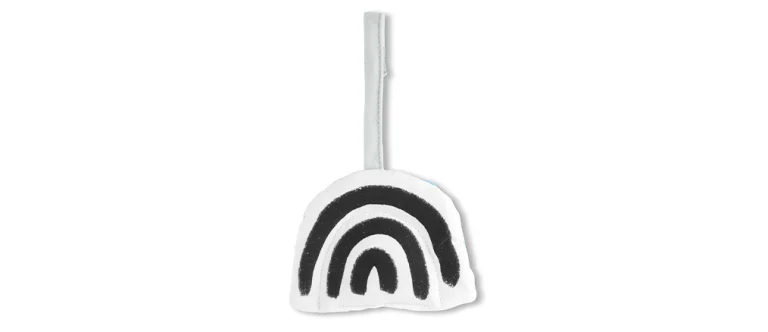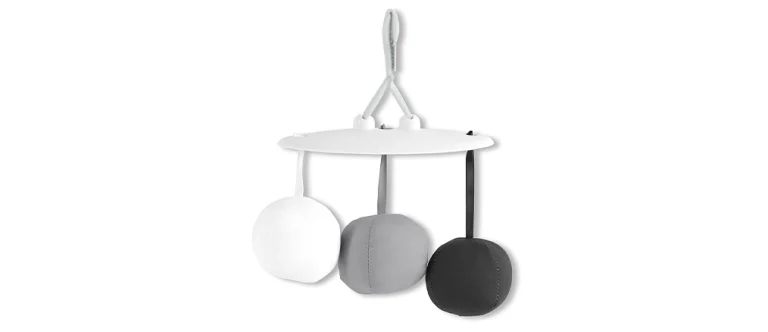
As Montessori educators and administrators with more than 50 collective years of experience in the field, we were thrilled when Skip Hop reached out to us to collaborate on the design of their new Montessori-inspired Discoverosity Play Gym. Before diving in, they wanted to be certain it would be consistent with the hands-on, self-directed, self-paced Montessori approach to learning, while also following what is developmentally appropriate. We appreciated their integrity and couldn’t be happier with what they came up with. Here’s why:


The Play Gym Is Beautiful
For starters, we think the Play Gym like Montessori learning materials in generalis beautiful, both to the sight and to touch. We especially love how the gentle colours and flowy patterns suggest elements of nature, such as the sun, the sky, a river, and rainbows. As Montessorians, we believe that an environment like this is soothing, the same as a walk in the woods or a lakeside lunch and serves as a gateway to learning.
You’ll see a similar approach to design in a Montessori classroom. Rather than being filled with distractions such as crowded bulletin boards, cartoon-character art, and overflowing baskets of crayons, which can overwhelm children and disrupt their focus and concentration, the spaces are quiet, peaceful, and clutter-free.
It Invites Exploration
We also believe that from birth, babies are naturally curious and learn by actively exploring what they can see and touch. Thus, we are delighted with the many ways in which the Play Gym sparks interest and invites engagement by even the youngest among us. It’s been much fun watching this firsthand with a newborn in our lives, who at the tender age of one week, for example, was mesmerized by the Gradation Mobile and remained so for the next several months, especially as his eye muscles strengthened and he could track the movement of the spheres when we tapped them with our finger.
He also seemed to stare endlessly at the Rainbow Rattle even before he was supposedly able to see colour, according to benchmarks of typical child development. It might be our imagination, but several months later, after grasping the rattle and hearing it make a “crinkle sound for the first time, we could swear we saw him smile. (We know for sure that we did.)

It Develops Along with Your Baby
As with the learning materials in a Montessori classroom, the various components of the Play Gym come into play to coincide with the growth and development of the baby. For example, the little one in our lives has gone from gazing at the Discovery Mirror during tummy time to reaching for it to finally grasping it, cuddling it (it’s also a soft plush toy), exploring it with his mouth, and currently, to focusing on the little face reflected back at him when he gazes at it. We don’t think he realizes yet that it’s his, but still….
We’ve also seen him engage with other components in changing ways, such as reaching for the teething tree while rolling over, scooting on his belly to grab it, and eventually transferring it from hand to hand—an action requiring hand-eye coordination and the “fine art” of crossing the midline of his body. Once he starts cutting his first tooth we anticipate he’ll start to chew on it to help relieve some of the discomfort. It amazes us how sometimes babies just instinctively know what to do.

The Play Gym Is Clever
Not only does the Play Gym invite engagement that progresses with the growth of your baby, but each of the components is designed to appeal to a different sense (sight, sound, touch), encourage movement, and support the development of specific skills—all of which are key aspects of the Montessori approach. Here are things we especially like about each:

The Playmat. It’s soft and washable and has different textures that beg to be touched. One part feels like velvet; others are like satin, cotton, and corduroy. Learning to tell them apart helps baby to develop their sense of touch and—like all the activities that are part of the Gym is something they can explore on their own, helping to build confidence as well as a sense of independence. We’re also drawn to the little flaps on the mat that make a crunchy sound when grasped. It reminds us of the sound of walking on autumn leaves.

The Cloud. We like that it's firm enough to put under baby to support their neck, back, and shoulder muscles during tummy time, while at the same time is as soft and cozy as a plush toy. Eventually, when baby is older, it might even be something they cuddle up with. It reminds us of the neck pillow some of us swear by when we’re traveling by plane— and possibly cuddle with, too!

The Wooden Ring. We are thrilled that the Ring is made of wood, which—unlike some other materials commonly used in toys is smooth, warm, and pleasant to the touch. We also like the little colourful ribbons that flutter from it, meant to catch the baby’s attention and encourage grasping. While babies have a grasping reflex at birth put your finger in a newborn’s palm and stroke it, and they will instinctively curl their fingers around yours—intentional grasping comes later, when muscle skills and hand-eye coordination are more fully developed.

The Rainbow Rattle. It’s hard to believe that such a small toy can have so many benefits! And that’s what delights us about the Rainbow Rattle. As your newborn gazes up at it hanging above them, they are strengthening their eye muscles and improving “eye teaming” (both eyes working together). Then, your somewhat older baby accidentally bats it with their hand. “Huh? What’s that sound?! Did I do that?! How can I do it again?!” Soon the involuntary batting becomes intentional, followed by grasping, which results in the Rattle making an even more crinkly sound. How fun for your baby to learn about cause and effect!

The Gradation Mobile. Ah, the delights of lying on one's back and staring up at a mobile! The sharply contrasting black, gray, and white colours are noticed right away even by a newborn, whose colour vision is still a work in progress. With time, as their vision strengthens, the edges of the three spheres come into focus and baby sees them as distinct objects rather than a single blur. How fascinating it is for them to follow them with their eyes when a breeze through an open window or door causes them to gently sway. To those who say babies have no sense of focus and concentration, we beg to disagree!
And oh, the joy when they discover what their reaching hand can do. It’s the simple things in life that we take for granted. The fact that three plain, unadorned spheres, hanging above them, can bring your baby so much delight, is what we love about this mobile.

The Exploration Mirror. You’ve probably noticed how much babies like looking at faces. That’s why we are so excited about this specially designed mirror. Special because it’s just the right size and height for baby to see their reflection when it’s placed in front of them during tummy time or off to the side when they’re on their back. And because it’s soft and unbreakable it’s actually one side of a plush toy they can safely grasp it to explore their reflection up close once they’re motor skills are more developed.
In addition, the flip side has a see-through pocket where you can insert a changing gallery of friend and family photos—including your own. (Say “Cheese!”) Enjoy this “baby version of FaceTime” and see how smiling really is contagious!













Why montessori education experts love the Skip Hop Discoverosity Play Gym